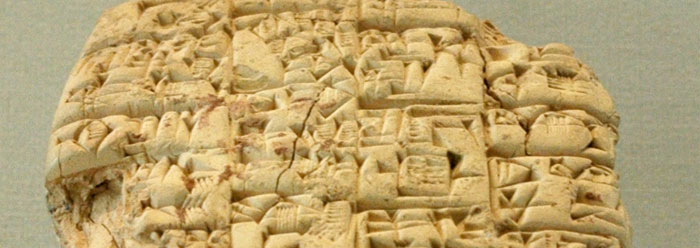Noah’s Flood was a worldwide cataclysm that destroyed all life on earth, except for the representatives of each kind of land and sky-dwelling creature that were saved aboard Noah’s Ark. The book of Genesis clearly gives the broad specifications of this Ark, but a newly translated ancient Babylonian clay tablet offers a different description that suggests that the Ark was round. Which depiction is more trustworthy?
During World War II, a history enthusiast named Leonard Simmons acquired the tablet when he was in the Middle East serving in the RAF. His son, Douglas, recently brought the artifact to Irving Finkel at the British Museum, who was able to read its ancient cuneiform.
The tablet was dated conventionally at about 3,700 years old, and it bears the kind of wear and tear associated with an artifact of great age. The script on it, however, was clear enough to translate, and The Guardian reported that the tablet summarized God’s message to Atram-Hasis, a Sumerian equivalent of Noah.
Wall, wall! Reed wall, reed wall! Atram-Hasis, pay heed to my advice, that you may live forever! Destroy your house, build a boat; despise possessions And save life! Draw out the boat that you will built [sic] with a circular design; Let its length and breadth be the same.1
Also according to this translation, Atram-Hasis was instructed to use “plaited palm fiber” for the boat’s construction.1 In contrast to reeds, the biblical Ark was built from wood. If Noah’s Ark really contained a host of animals and a year’s worth of provision, then reeds were clearly an inadequate construction material.2
The biblical dimensions for a large, barge-like watercraft may be a perfect balance to meet the needs for comfort, hull strength, and stability on water during a violently turbulent flood event.3 If a circular vessel started to spin on the water, it would make a mess of its contents. Therefore, the biblical Ark was more realistic a vessel than the one depicted in the Sumerian translation.
The Guardian also thrice repeated the assertion that Genesis borrowed from supposedly earlier Mesopotamian sources. But this ignores textual and other evidence that Genesis 1-11 was based on direct, eyewitness accounts.4 Eminent archaeological linguist W. F. Albright even wrote that “the Bible record contains archaic features dating it to before any Mesopotamian version that is preserved in cuneiform sources.”5
The fact that so many ancient sources from around the world, as well as the New Testament writers, all agree that there was a great, global flood lends credence to the fact of the Flood’s existence.6 The realistic parameters for the Ark provided in Genesis are evidence that the biblical account is a trustworthy account of real history, unlike this newly translated clay tablet and other fanciful ancient writings.
References
- Kennedy, M. Relic reveals Noah’s ark was circular. The Guardian. Posted on guardian.co.uk January 1, 2010, accessed January 7, 2010.
- Woodmorappe has generously estimated that 16,000 individual animals, including two of every extinct and extant animal genus (including juvenile dinosaurs) and seven of every bird, would have taken less than half of the volume of the biblical ark. See Woodmorappe, J. 1998. Noah’s Ark: A Feasibility Study. Santee, CA: Institute for Creation Research, 10, 16.
- Hong, S. W. et al. 1993. Safety investigation of Noah’s Ark in a seaway. Technical Journal. 8 (1): 26-36. See also Lovett, T. Noah’s Ark: Optimal Proportions. Posted on worldwideflood.com September 2006, accessed January 8, 2010.
- Livingston, D. From What Did Moses Compose Genesis? Posted on biblearchaeology.org December 26, 2005, accessed January 8, 2010.
- Albright, W. F. 1968. Yahweh and the Gods of Canaan: An Historical Analysis of Two Contrasting Faiths. New York: Doubleday. Quoted in Wilson, C. The Bible Comes Alive: A Pictorial Journey Through the Book of Books, Volume 1. Green Forest, AR: New Leaf Press, 13.
- Lorey, F. 1997. The Flood of Noah and the Flood of Gilgamesh. Acts & Facts. 26 (3).
* Mr. Thomas is Science Writer at the Institute for Creation Research.
Article posted on January 15, 2010.




